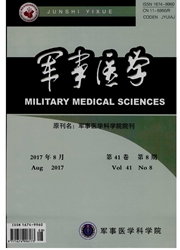

 中文摘要:
中文摘要:
目的 建立能同时检测人细小病毒B19(简称B19病毒)3种基因型的通用核酸检测(NAT)体系,并进行方法学评价。方法 对B19病毒3种基因型代表毒株全序列进行比对,选取其保守区域(NS1区)设计B19病毒的通用引物和探针。为避免假阴性结果,在体系中引入竞争性噬菌体内标。将适宜浓度的内标添加到一系列梯度稀释的参考品质粒中,建立B19病毒实时荧光定量PCR(q PCR)标准曲线。对建立的B19病毒通用NAT体系分别进行敏感性、特异性、重复性等方法学评价。结果 建立的B19病毒实时q PCR检测体系的标准曲线在1×109~1×10^3拷贝(copies)/μl模板浓度范围内相关性良好。方法学评价显示,体系的最低检测下限为10拷贝/μl;与其他血源传播病毒等无交叉反应;批内和批间实验重复性良好。结论 建立了B19病毒3种基因型全检的通用NAT体系,不仅可用于B19病毒感染的诊断,还可用于血液和血液制品中B19病毒的NAT筛查,对于保障输血和血液制品的病毒安全性具有重要意义。
 英文摘要:
英文摘要:
Objective To establish and evaluate a universal real-time fluorescent quantitative PCR(qPCR) method for identifying and quantifying three human parvovirus B19 (B19V) genotypes. Methods Firstly, following a bioinformatie analysis of a subset of B19V genomic sequences available in the NCBI nucleotide database, representative of genotypes 1 to 3, a set of suitable universal primers and TaqMan probes was designed from the NS1 gene of B19V. Aplasmid was used as a quantitative standard that contained the identical sequence of the B19 target sequence. An internal control (IC) was included to prevent false negative resuhs. Then, serial l-log dilutions of quantitative standards were prepared and used in the qPCR assays for generation of a standard curve. Finally, the specificity, sensitivity and reproducibility of the assay were assessed. Results A linear relationship of the real-time PCR method for detecting B19V from 1 × 10^9copies/μl to 1 × 10^3 copies/μl was observed. The developed qPCR protocols allowed for the detection of genotypes 1 to 3 with a limit of detection (LOD) of 10 copies/μl. Furthermore, the assay did not amplify other blood-borne viruses. The inter-and intra-assay variability analyses showed good reproducibility of the assay. Conclusion A universal real-time qPCR method for the detection of B19V DNA is established, which will facilitate the diagnosis of B19V infections and the screening of blood and plasma-derived products, thereby improving the viral safety of transfusion and plasma-derived products.
 同期刊论文项目
同期刊论文项目
 同项目期刊论文
同项目期刊论文
 期刊信息
期刊信息
